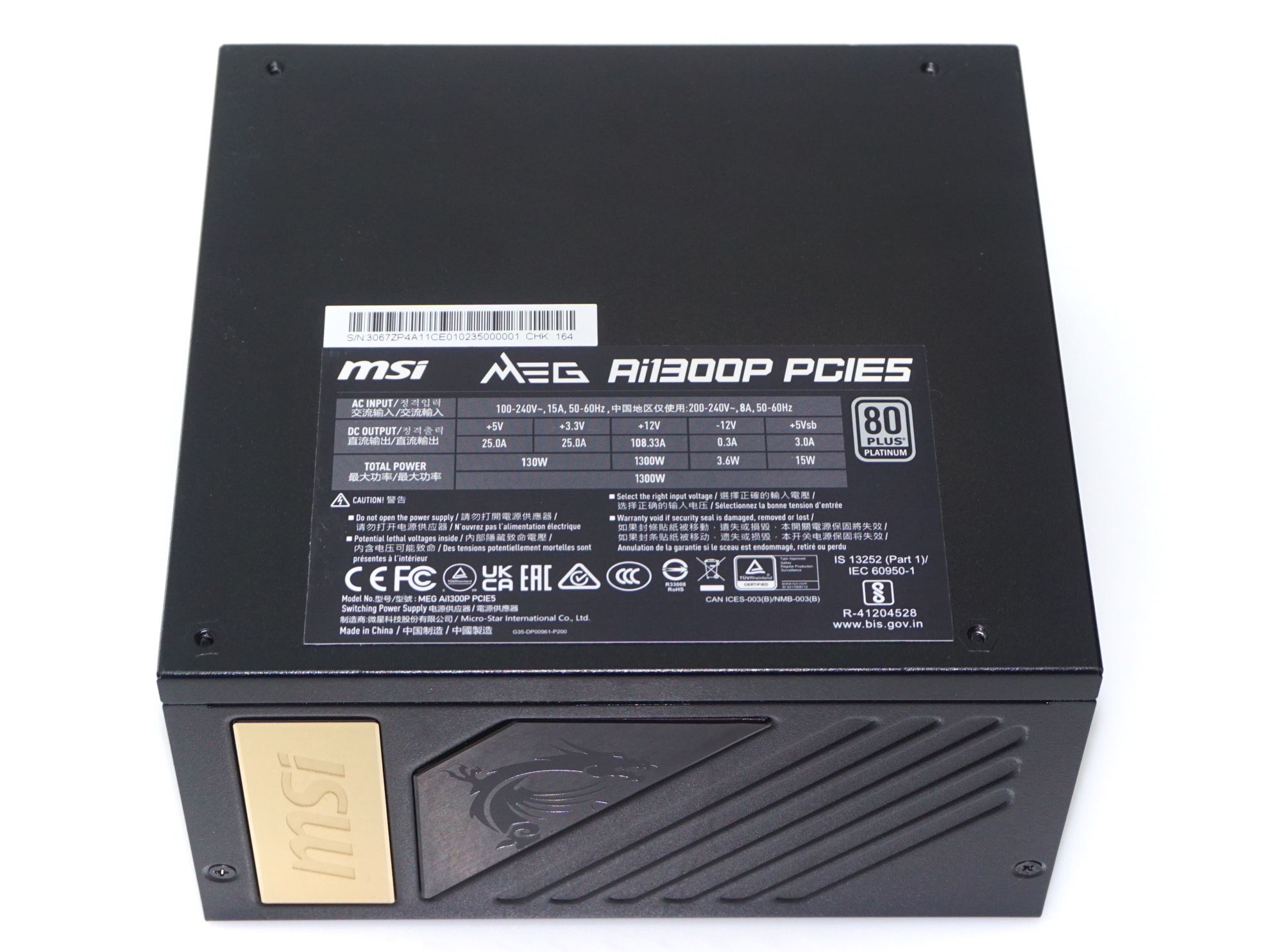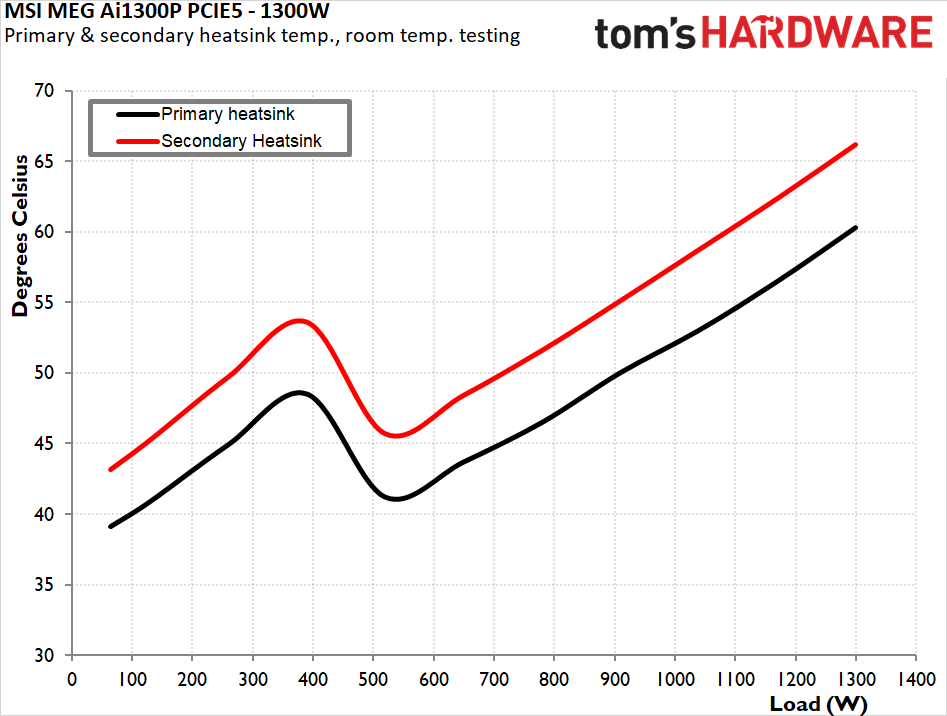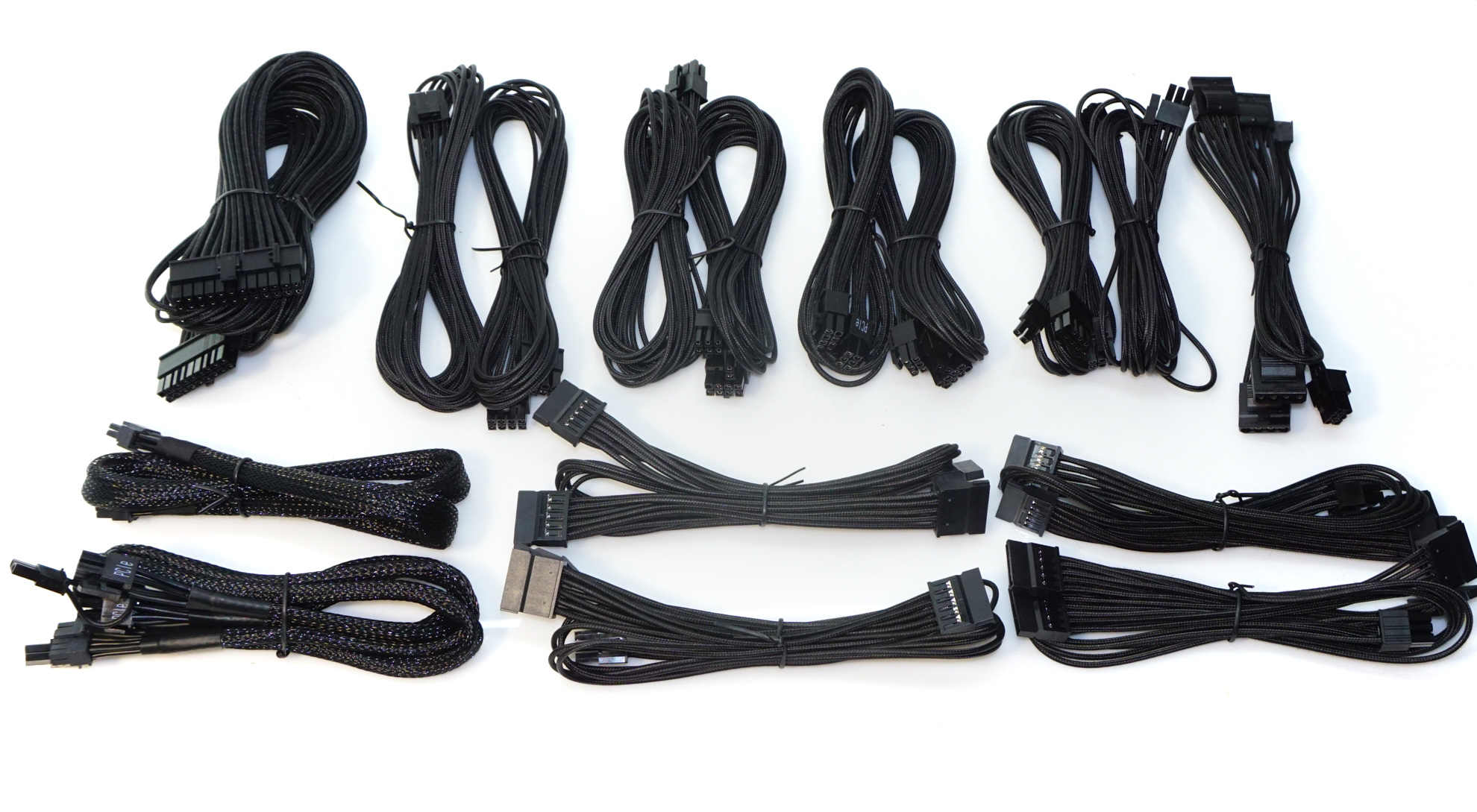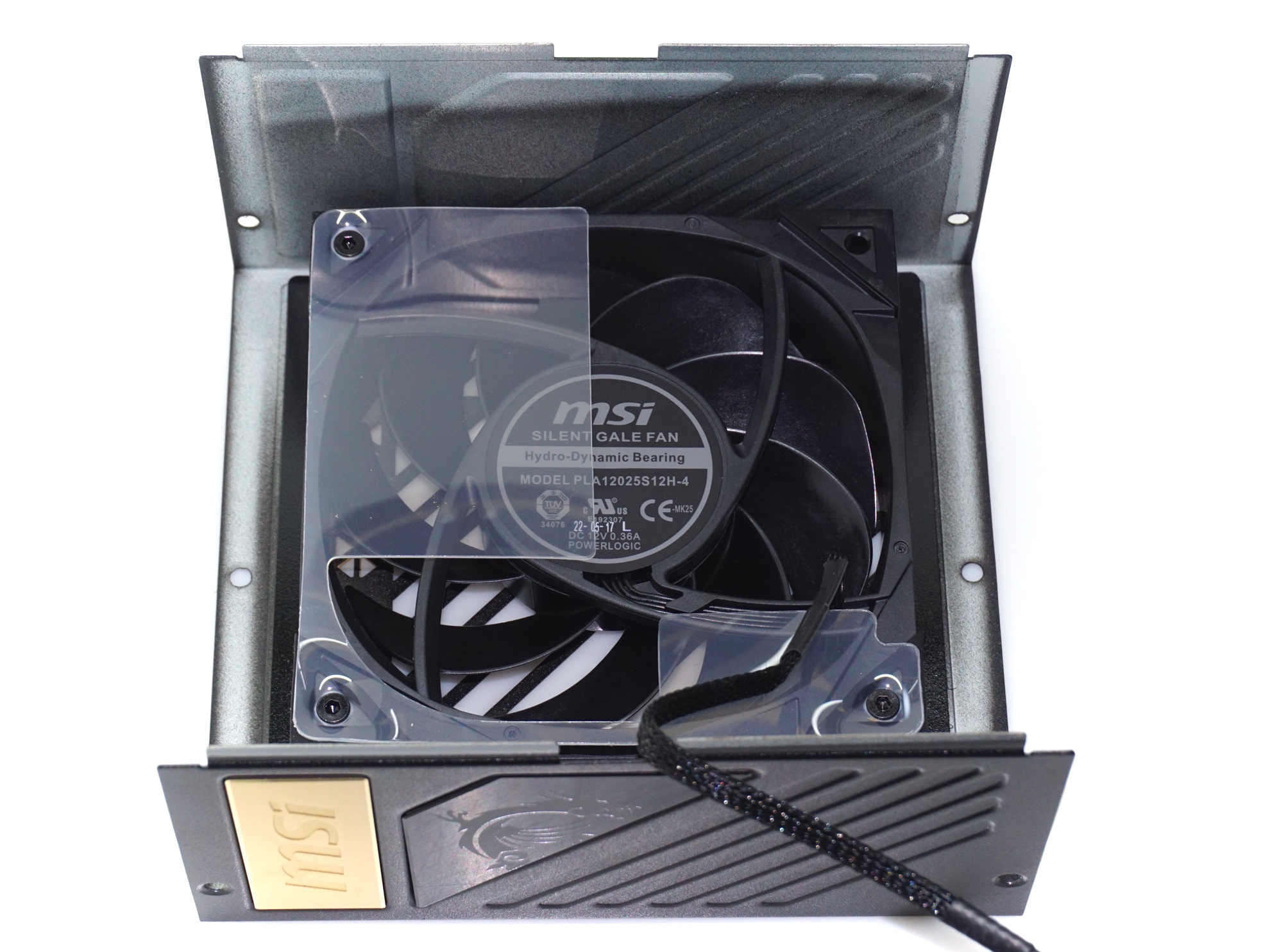Tom's Hardware Verdict
The MSI MEG Ai1300P PCIE5 is an impressive ATX 3.0-compliant PSU that excels in power quality and thermal performance. However, its high price and increased fan noise under heavy loads may be drawbacks for some users.
Pros
- +
Great efficiency
- +
Amazing voltage filtering
- +
Very resilient to high temperatures
- +
Long warranty
- +
Compact for its power output
Cons
- -
Expensive
- -
Noisy under heavy load
- -
Limited fan size
- -
Loose 12V regulation
- -
Only one 12+4 pin GPU connector
Why you can trust Tom's Hardware
In today’s review, we are taking a look at MSI’s first ATX 3.0 compliant power supply, the MEG Ai1300P PCIE5. A beefy, 1300W PSU that is designed to be fully compliant with the ATX 3.0 specification, the Ai1300P is a look at what’s to come for the future of high-end PC PSUs, as the market slowly-but-inevitably incorporates ATX 3.0 compliance in order to feed ever more power-hungry video cards and other PCIe devices.
MSI claims that their unit also is the first ATX 3.0 Ready PSU on the market – and although that may be true by some small margin, it does not really say anything about the product itself. The specifications of the MEG Ai1300P PSU that we are reviewing today are extremely impressive, as expected from the flagship product of a premium brand. So for this review we’ll be examining its overall performance, reliability, and of course, taking our first stab at checking for ATX 3.0 compliance.
Specifications and Design
| RAIL | +3.3V | +5V | +12V | +5Vsb | -12V |
| MAX OUTPUT | 25A | 25A | 108.33A | 3A | 0.3A |
| Row 2 - Cell 0 | 130W | Row 2 - Cell 2 | 1300W | 15W | 3.6W |
| TOTAL | 1300W | 1300W | 1300W | 1300W | 1300W |
| AC INPUT | 100 - 240 VAC, 50 - 60 Hz | 100 - 240 VAC, 50 - 60 Hz | 100 - 240 VAC, 50 - 60 Hz | 100 - 240 VAC, 50 - 60 Hz | 100 - 240 VAC, 50 - 60 Hz |
| PRICE | $360 | Row 5 - Cell 2 | Row 5 - Cell 3 | Row 5 - Cell 4 | Row 5 - Cell 5 |
In the Box
MSI supplies the MEG Ai1300P PCIE5 in a large, sturdy cardboard box that provides ample shipping protection to the product inside it. The artwork on the box is rather simplistic and based on a picture of the unit itself. Information on the specifications and certifications of the PSU can be found on all sides of the box, with the logos at the front advertising its ATX 3.0 support.
Instead of cable ties or straps, MSI supplies a number of plastic wire combs. These are quite a bit tedious to install but the outcome is visually superior to basic tied wires. Inside the box, we also found the typical AC power cable and four black mounting screws.
The MEG Ai1300P PCIE5 PSU is a fully modular design, allowing for the removal of every DC power cable, including the 24-pin ATX connector. Most of the cables have individually sleeved black wires and black connectors. Only the 16-pin PCIe 5.0 12VHPWR cable and one cable with two PCIe 8-pin connectors have black wires but are wrapped in a single sleeve.
| Connector type | Hardwired | Modular |
|---|---|---|
| ATX 24 Pin | - | 1 |
| EPS 4+4 Pin | - | 1 |
| EPS 8 Pin | - | 1 |
| PCI-E 5.0 | - | 1 |
| PCI-E 8 Pin | - | 8 |
| SATA | - | 16 |
| Molex | - | 4 |
| Floppy | - | 1 |
External Appearance
MSI is one of the few companies that has invested so much in the external appearance of PSUs, especially with the MEG series. Most of the chassis is covered with embossed geometrical shapes and triangular patterns, with a few golden parts. The satin black paint is very smooth and resistant to fingerprints. The fan finger guard is entirely custom and part of the chassis itself. Despite the massive power output, the PSU is just 160 mm long, making it compatible with practically any ATX-compliant case.
The sticker with the unit’s electrical certifications and specifications covers about half the top side of the PSU. Decorative golden and black metallic plates can be found on the sides of the unit, which plates are magnetically attached and can be flipped to match the installation orientation of the PSU.
Get Tom's Hardware's best news and in-depth reviews, straight to your inbox.

A typical on/off switch can be seen at the rear side of the unit right next to the power connector. The front side of the unit is entirely covered by the numerous connectors for the modular cables. A golden legend is printed on the chassis. The tiny Mini-USB connector sits right above the large ATX 24-pin connectors, with the G.I. (i.e. Gaming Intelligence) legend printed right over it.



Internal Design
The 120 mm cooling fan of the MEG Ai1300P is made by PowerLogic for MSI. It features a hydro-dynamic bearing and, as MSI calls them, “liquid-crystal polymer” fan blades that are supposed to be better balanced and more durable than normal blades. MSI probably could not use a 135 mm fan due to patent restrictions and 140 mm fans do not fit in 160 mm bodies with vertical connector daughterboards, so they had to stick to the 120 mm fan instead.
The OEM behind the creation of the MSI MEG Ai1300P is Channel-Well Technologies, or CWT. They are a very popular and reputable manufacturer of mid-to-high-performance PC PSUs. This platform can be described as a hybrid, as it essentially is a standard analog platform but with extra digital electronics added to it. The digital electronics allow for the monitoring of the unit’s basic performance figures, as well as limited control (fan cooling profile, OCP limits, etc) via the USB interface. What really does stand out is the heatsinks, which do have plenty of dissipation surface but are also designed to be aesthetically appealing – an odd (but not unwelcome) design choice considering they should not be visible to the end user.


Electronic circuitry aside, the platform that the MEG Ai1300P is based upon is quite standard and proven. The filtering stage begins on the rear of the AC switch, with six Y capacitors, two X capacitors, and two filtering inductors. It is more than what specifications require but not overly large for such a design. The filtering stage leads to two large rectifying bridges, which are placed on their own heatsink.



The passive components of the APFC circuitry are two beefy 400V/680μF APFC capacitors made by Nichicon, followed by two filtering coils. The active APFC components are on the longest heatsink of the unit. Four transistors can be found on their own heatsink and these form the full-bridge inversion topology at the primary side of the unit. The output of the main transformer is connected to six power MOSFETs that generate a single 12V rail. The 3.3V and 5V lines are being generated via the DC-to-DC conversion circuits. All of the secondary capacitors, electrolytic and polymer alike, are made by Rubycon and Nippon Chemi-Con.


Overall, one quick takeaway from this is that while ATX 3.0 does require more reliability and performance out of high-end PSUs than past versions of the standard, it's not a radical difference. Consequently, neither are the first designs for ATX 3.0 PSUs. MSI's MEG Ai1300P is still built more or less like any other high-end PSU, for both the good and the bad. Thus while there is certainly room for innovation and optimization here, making an ATX 3.0-compliant PSU does not mean OEMs will have to throw out the rule book on PSU design – at least for units above 1000 Watts.
Cold Test Results
Cold Test Results (25°C Ambient)
For the testing of PSUs, we are using high precision electronic loads with a maximum power draw of 2700 Watts, a Rigol DS5042M 40 MHz oscilloscope, an Extech 380803 power analyzer, two high precision UNI-T UT-325 digital thermometers, an Extech HD600 SPL meter, a self-designed hotbox and various other bits and parts.





The efficiency of the MSI MEG Ai1300P does meet the 80Plus Platinum certification requirements when it is powered from an 115 VAC source. However, when the main’s voltage is 230 VAC, the efficiency is raised by an average of 1%, which is not enough to meet the 80Plus Platinum requirements for that input voltage. The average nominal load efficiency (20% to 100% of the unit's capacity) is 92.1% with the unit powered from a 230 VAC source, and drops down to 91.3% if the unit is powered by a 115 VAC source. It is also interesting to note that its efficiency under very low loads is quite high, at above 83% for a 5% load.
The fan of the MSI MEG Ai1300P PCIE5 is thermally controlled by default, with the unit keeping it disabled until the load was over 430-440 Watts. Regardless, the internal temperature of the PSU is quite low considering the massive power output. Once the fan does start, it is very quiet at first but then speeds up very quickly as the load increases, making the Ai1300P clearly audible when the load is greater than 800 Watts.
Hot Test Results
Hot Test Results (~45°C Ambient)
The resistance of the MSI MEG Ai1300P PCIE5 unit to adverse ambient conditions is astonishing, with the unit hardly affected at all while operating inside our hotbox. There is a practically negligible efficiency degradation of 0.2-0.3% depending on the load, a figure four to six times lower than other similar designs. There is very little additional degradation under heavy loads, suggesting that the components of the MSI MEG Ai1300P PCIE5 are not thermally stressed at all.





Despite the exceptional resilience of the PSU against high ambient temperatures and its 80Plus Platinum efficiency levels, the losses of a unit this powerful sum up to over 100 Watts under high loads. These losses do increase the internal temperature of the PSU significantly but the cooling system of the MSI MEG Ai1300P PCIE5 proves to be more than adequate, as the temperature of the critical components does not get anywhere near critical levels during our testing. As a matter of fact, the MSI MEG Ai1300P PCIE5 delivers lower temperature figures than many units with significantly larger bodies and fans do.
The sizable heatsinks of the MSI MEG Ai1300P PCIE5 seem to be collaborating excellently with the 120 mm PowerLogic fan at keeping the temperature of the critical parts low. With the PSU inside our hotbox, the fan started quicker and sped up even faster, reaching its maximum speed while the PSU was at just 70% load. Regardless, the internal temperatures of the unit kept rising almost linearly and were kept within safe levels.
PSU Quality and Bottom Line
Power Supply Quality
The electrical performance of the MSI MEG Ai1300P PCIE5 1300W PSU is very good overall. Our instruments recorded a maximum ripple of 32 mV on the 12V line with a recommended design limit of 120 mV, an excellent figure for a PSU with that kind of power output. The filtering of the minor voltage lines is even better, with a maximum of 12 mV and 14 mV on the 3.3V and 5V lines respectively. Voltage regulation on the minor lines is very tight, with both lines staying within 0.8% across the load range. Strangely, especially for the CWT platform, the voltage regulation of the 12V line is much looser, at nearly 2%. This still is a very good figure but uncharacteristic of the particular OEM or class of this PSU.
| Load (Watts) | 264.41 W | Row 0 - Cell 2 | 659.2 W | Row 0 - Cell 4 | 975.71 W | Row 0 - Cell 6 | 1297.87 W | Row 0 - Cell 8 |
| Load (Percent) | 20.34% | Row 1 - Cell 2 | 50.71% | Row 1 - Cell 4 | 75.05% | Row 1 - Cell 6 | 99.84% | Row 1 - Cell 8 |
| Amperes | Volts | Amperes | Volts | Amperes | Volts | Amperes | Volts | |
| 3.3 V | 2.32 | 3.37 | 5.79 | 3.37 | 8.68 | 3.36 | 11.58 | 3.35 |
| 5 V | 2.32 | 5.06 | 5.79 | 5.05 | 8.68 | 5.03 | 11.58 | 5.02 |
| 12 V | 20.07 | 12.2 | 50.16 | 12.17 | 75.24 | 12 | 100.33 | 11.97 |
| Line | Regulation (20% to 100% load) | Voltage Ripple (mV) | Row 0 - Cell 3 | Row 0 - Cell 4 | Row 0 - Cell 5 | Row 0 - Cell 6 | Row 0 - Cell 7 |
| Row 1 - Cell 0 | Row 1 - Cell 1 | 20% Load | 50% Load | 75% Load | 100% Load | CL1 12V | CL2 3.3V + 5V |
| 3.3V | 0.85% | 10 | 10 | 12 | 12 | 10 | 14 |
| 5V | 0.90% | 12 | 12 | 14 | 14 | 14 | 14 |
| 12V | 1.90% | 18 | 26 | 28 | 32 | 30 | 26 |
As part of our standard testing, we test the primary protections of all PSUs we review (Over Current, Over Voltage, Over Power, and Short Circuit). The MSI MEG Ai1300P PCIE5 successfully passed all of the tests, generally reacting timely when needed and shutting down to protect itself and the components it is powering. The OCP protection is a little slow but does kick in when necessary – probably a side effect of the high power excursion figures dictated by the ATX 3.0 standard.
Bottom Line
The MEG Ai1300P PCIE5 marks a lot of milestones for MSI – it is their first ATX 3.0 compliant unit, the world’s first ATX 3.0 compliant unit, and remains their flagship PSU product to this date. Needless to say, the MEG Ai1300P has to meet very high expectations, both by the users and by MSI themselves.
MSI placed a lot of effort into the uniqueness of the MEG Ai1300P in terms of appearance. The company went with a fully customized chassis and metallic side decorations, using contrasting body colors but not fancy lighting, for a seamless and elegant look. From a practical point of view, the chassis of the massively powerful unit is just 160 mm long, making it compatible with any ATX-compliant case. The odd point here is the two cables which are fully sleeved instead of having individually sleeved wires like the rest of them.
In terms of electrical performance, the MSI MEG Ai1300P PCIE5 does deliver. Keeping its massive power output in mind, the MEG Ai1300P manages outstanding power quality, with excellent voltage regulation and remarkable filtering. MSI’s engineers did not neglect the minor voltage lines either, which often are not as well filtered as the main 12V line. The efficiency of the MEG Ai1300P barely meets the 80Plus Platinum certification standards but it is extremely stable and practically unaffected by high ambient temperatures. It also is very efficient at very low loads, which is important for a unit with a very high-power output.
The use of a 140 mm fan was not possible due to the small chassis, forcing MSI’s engineers to resort to a 120 mm fan. Although the quality of the fan is exceptional, its smaller size of it inevitably means that it needs to spin faster in order to create the required airflow. This does not necessarily mean that all 135/140 mm fans would be quieter but most quality products would generate at least a little less noise for the same amount of airflow. Ultimately, the fan of the MEG Ai1300P does a great job at keeping the internal temperatures of the PSU very low but it does get noisy when the load and/or the ambient temperature are very high.
To summarize, the MSI MEG Ai1300P PCIE5 is a powerful PSU, very well made and with very good overall performance. Currently, its primary selling point is the ATX 3.0 compliance and the new 12VHPWR/PCIe 5.0 connector, which is in our opinion a necessity for anyone who is going to purchase a graphics card that uses it. While many older PSUs can handle the power requirements of such a card, there are frequent issues with the 12VHPWR adapters and it is counterintuitive to risk damage to a $1000+ card for the price of a great PSU.
When it can be found in stock, the MEG Ai1300P currently retails for $310, which is quite high for a PC PSU, yet not unreasonably high considering the current state of the market and the features it offers. Builders who do not currently intend to use an NVIDIA RTX 4000 series card card but also frequently upgrade should also consider the MEG Ai1300P, as it should last them for many years and endless system changes/upgrades without having to swap a PSU again.
MORE: Best Power Supplies
MORE: How We Test Power Supplies
MORE: All Power Supply Content

Dr. E. Fylladitakis has been passionate about PCs since the 8088 era, beginning his PC gaming journey with classics like Metal Mutant and Battle Chess. Not long after, he built his first PC, a 486, and has been an enthusiast ever since. In the early 2000’s, he delved deeply into overclocking Duron and Pentium 4 processors, liquid cooling, and phase-change cooling technologies. While he has an extensive and broad engineering education, Dr. Fylladitakis specializes in electrical and energy engineering, with numerous articles published in scientific journals, some contributing to novel cooling technologies and power electronics. He has been a hardware reviewer at AnandTech for nearly a decade. Outside of his professional pursuits, he enjoys immersing himself in a good philosophy book and unwinding through PC games.






